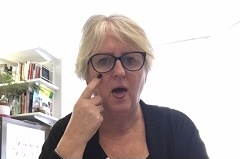
During this week, York St John University has marked BSL week by raising awareness of deaf students accessing higher education. To give an insight, within YSJ there are approximately 46 deaf students (according to the declarations made on their UCAS forms). I have sought to discover more about BSL during this week by interviewing members of staff around YSJ to gain an insight into the obstacles and misunderstandings associated with BSL and deafness itself.
It has been a pleasure to interview BSL lecturers – Amanda Smith and Dai O’Brien and by doing so, I myself feel like I have been educated on how academic institutions can support deaf students that wish to access higher education.
The following answers have been transcribed from the Zoom interview. The answers given are a direct interpretation from a BSL interpreter. If you wish to read the full transcription – click here.
Do you believe there are barriers to education, in particular higher education, for deaf students and staff? And if so, what are they?
Dai O’Brien: ‘I think really, the barriers don’t just start later on in life, barriers start from as soon as a child’s born, and it comes back to accessing language. If they can’t access any language, that’s where the problems arise and that delay instantly happens. And that’s one of the hardest things for deaf people, they’re always having to play catch up. So, it means a lot of students don’t actually arrive at university because they’ve not got through the educational system. In terms of our role as deaf staff, we get extra responsibility. We have to do things like book all the interpreters, we’ve got to make sure that we have the support in place and that provides a lot of extra work and I think hearing staff don’t necessarily realise they don’t have those extra responsibilities.’
Amanda Smith: ‘It comes back to awareness. When you think about a deaf student, if they arrive at the university, the staff really need to be prepared to provide an interpreter, you can’t book an interpreter last minute, you need to think about what it is that the deaf student needs.
How has the COVID-19 pandemic influenced these barriers?
Amanda Smith: ‘With the masks before, staff would come up and touch you, so they’d know that we’re deaf. If they’d want to communicate, they’d actually come and just tap you on the shoulder to get your attention. Now, with COVID-19 its oh no, you can’t go near them, you’ve got the two-meter rule, so there’s extra difficulties that happen.’
Dai O’Brien: ‘I would say yes, it has. For hearing people, you can still have those incidental conversations asking if they are okay and then off you go. However, for deaf people, conversations and communication can be a lot harder. It makes you feel a little paranoid because you don’t know if someone’s talking or not. You can’t see the lips moving so a bit of paranoia sneaks in because you have no idea what’s going on behind the masks.’
How can academic institutions, like YSJ help to break down these barriers?
Dai O’Brien: ‘The few tips is don’t be frightened to use gestures or writing or other methods like using your phone to communicate. There are voice recognition apps that you can download, don’t be embarrassed to try different things. There are three apps that I recommend. One of them is Make it Big for both Android and Apple and the others are otter.ai and Live Transcribe. So, you can use a mis of these three apps to communicate. When you’re talking about the academic, it’s really about awareness, they can look at deaf history, language deprivation and oppression of audism and that’s a really important thing for people to be aware of – that deafness itself is not a learning disability.’
Amanda Smith: ‘Maybe worth everybody downloading the voice recognition app, so it means it’s prepared. If you see a deaf person, it means you can just speak into it so it might be worth recommending this. You’ve also got to think about all these little things like bringing pen and paper. You’ve got to think about these different communication strategies but with masks, it’s a really difficult thing. It comes down to common sense – it’s common sense and just thinking of how you can communicate with people.’
Do you think that BSL Learn to Sign week makes a difference and how can others get involved?
Dai O’Brien: ‘For BSL week, there’s positives and negatives. In terms of awareness it does improve, people might learn a little bit of basic sign language, but a lot of people then think oh I’ve learnt sign language, or I can sign! But they don’t think about everything else, the deaf culture and the oppression that takes place. Amanda will be doing both BSL and Awareness courses when we return to campus, so I think it’s going to be really worth people looking at YSJ website.’
Amanda Smith: ‘I agree with Dai, t’s very surface level, there’s nothing in depth. There’s nothing rich about it, they need to get into looking at all the different aspects of deafness. Obviously, last year we’ve had to postpone everything but this September we’re going to start campaigning to get people around campus aware and I believe the course are extra-curricular, so it is a way of welcoming everybody.’
By Student Intern,
Katy Harris


